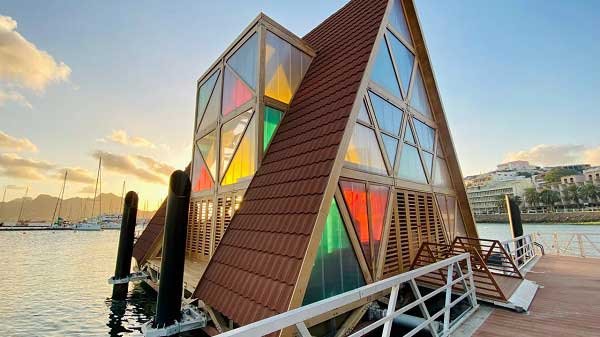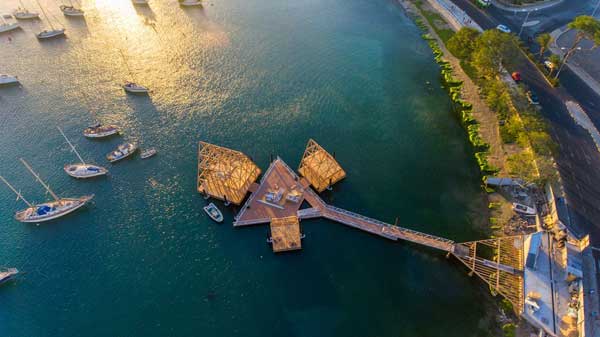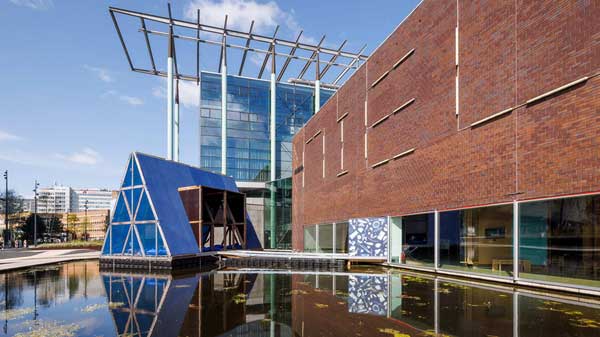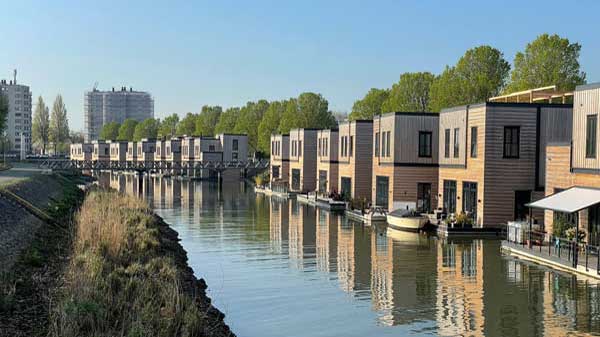July 2023
As we try to address the climate crisis, there are realities of our changing climate that we already have to live with.
Sea levels are rising faster and faster, and US coastlines are estimated to be 10 to 12 inches higher by 2050. The UN Secretary-General has warned that entire communities and countries could disappear as a result in the coming decades; the danger is especially acute for the approximately 900 million people living in low-lying coastal areas.
Many of these vulnerable communities have already faced devastating floods. But instead of building seawalls to keep the water out or putting houses on stilts, some architects are designing a future where we live with the water - and on it.
 The Floating Music Hub in Mindelo, Cape Verde. - Courtesy NLE
The Floating Music Hub in Mindelo, Cape Verde. - Courtesy NLE
Proposals for entire "climate-resilient" floating cities (including an ambitious ocean settlement in South Korea and one large enough to house 20,000 people in the Maldives) have made headlines. But existing projects, from Lagos to Rotterdam, show what life on water could look like - and in ways that can be scaled up.
A new exhibition at the Netherlands' New Institute, "Water Cities Rotterdam", showcases the work of NLE, an architecture firm led by Kunle Adeyemi that has researched and tested floating architecture around the world. A series of floating pavilions, stemming from the Amsterdam and Lagos-based firm's acclaimed Makoko Floating School project, are in the museum's ponds.
 An aerial image of NLE's Floating Music Hub. - Courtesy NLE
An aerial image of NLE's Floating Music Hub. - Courtesy NLE
Makoko is a central neighborhood in Lagos, Nigeria, where thousands of people live in informal wooden structures built on stilts in the lagoon. Inspired by this settlement, Adeyemi built a school for the residents in 2012.
During a video interview, the architect looked back at a massive flood that hit Lagos in 2011: "Entire streets were flooded and I realized that cities will flood, but the people of Makoko were already adapting. It was like a revelation."
A-frame's triangular wooden school was accessible by boat and contained sheltered classrooms and a common play area for dozens of children. The structure did not stand on stilts, but floated on a base of plastic drums. (The school collapsed a few years later, although NLE clarified that it was always meant to be temporary and claimed that lack of maintenance and collective management had led to its deterioration.)
Adeyemi's practice learned from this project and from ongoing research - much of which is included in his new book "African Water Cities" - and subsequently developed the Makoko Floating System (MFS), a group of durable wooden structures that can be quickly assembled and disassembled when and where needed. The system is modular, with more efficient steel connections and is highly designed to meet European building codes.
 Kunle Adeyemi's Water Cities Rotterdam Exhibition
Kunle Adeyemi's Water Cities Rotterdam Exhibition
The MFS consists of prefabricated, flat components that can be built by a team of five people in two weeks, without heavy equipment or cranes. "Our goal is to create an inclusive solution that leaves no one behind in this phase of climate adaptation," Adeyemi said, "and to ensure that, as the world evolves, we are able to include the most vulnerable communities."
The system offers small, medium and large versions of the triangular A-frame structure. Adeyemi believes the MFS can be used for a variety of purposes, from housing to education, and is "a solution that can be applied globally." He has built the system in several countries - including Italy, Belgium and China - to test it in different climate and water conditions.
In 2021, the concept took semi-permanent roots in Mindelo, a port city in Cape Verde off the coast of West Africa, in the form of a floating "music hub." Spread across three triangular pavilions of wood and steel, the cultural center includes a performance space, bar, canteen and recording studio floating in the sea and connected to the shore by a walkway.
That a version of Adeyemi's MFS is now on display in Rotterdam is perhaps fitting: Rotterdam is the city in the Netherlands most vulnerable to rising water. Since 90 percent of the city is below sea level, the sight of floating architecture is nothing new. Examples of design firms struggling with a watery future can be found all over the city.
One project completed this year, called Nassauhaven, consists of 17 floating homes designed by local firm Public Domain Architects (PDA). The design won a competition by the city government to develop a pilot floating architecture project that could secure Rotterdam's future.
"We are a delta city and water levels are changing," PDA's CEO Pieter Figdor said via video interview. He noted that interest in floating buildings is growing - a floating office complex and a floating farm have also opened in the city in recent years.
 Dubbed a "floating street", Nassauhaven is a residential development in the Dutch city of Rotterdam - Public Domain Architects
Dubbed a "floating street", Nassauhaven is a residential development in the Dutch city of Rotterdam - Public Domain Architects
Nassauhaven was promoted as the city's first floating housing development. The project, with the homes arranged in neat rows, is called a "floating street". The wooden houses stand on concrete pontoons attached by piles to the bottom of the harbor - and by walkways to land. They rise and fall gently with the daily tides, while remaining stable and comfortable for residents. The buildings are designed to be zero energy, with sustainability features such as solar panels, biomass heating and on-site wastewater treatment.
Figdor sees building on the water as one of the few options left when it comes to new housing in Rotterdam. He also believes it is more resilient than simply building barriers to keep water away from buildings on land. "On the water you are safest for climate adaptation", he said.
PDA is working on more floating projects, both in Bangladesh and Rotterdam. The company also hopes to expand the pilot in Nassauhaven: "Now we want to make a small floating neighborhood of about 100 homes," Figdor said. Adeyemi has similar plans for an MFS neighborhood in Amsterdam, which already has communities of floating homes, and his company is working to expand its system of floating structures to include multi-story "water scrapers."
Adeyemi believes that not enough research has been done on how to build and live on water, which makes up 70 percent of the earth's surface. The work on view at the New Institute and in the architectural exhibition.
Reference(s) .. edition.cnn.com